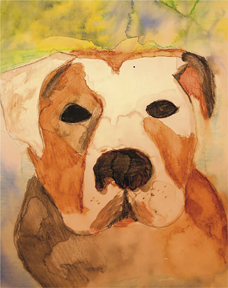You’ve seen them swaggering down the street, muscular bodies straining at the leash—if they even have a leash—spiked collars sparkling in the sun: Pit bulls out on the town.
It’s hard to imagine another breed that inspires so many conflicting emotions: fear, love, hate, pity. So, what’s the truth about this much-maligned breed?
“I have three pit bulls and three children,” says Niki Dawson, president of the animal welfare federation of New Jersey. “I had five children, but the pit bulls ate two of them.” This macabre joke gets to the heart of the pit bull’s image problem. A lot of folks can’t even imagine kids and pit bulls in the same sentence let alone in the same house.
“I know a wonderful couple whose new landlord took one look at their pit bull and said she had to go,” says Dawson. “He wouldn’t allow pit bulls in the building. And some homeowners insurance won’t cover you if you own certain breeds, including pit bulls.”
Dawson says the bad rep started back in the 1800s. “They were bred specifically for fighting in pits to the death,” she says. “They were bred for their aggression. That type of drive can exist in bloodlines today, which makes them difficult to appropriately place with a family.”
But their history isn’t all bad. They were a World War I mascot, and the Little Rascals’ dog Pete was a pit bull. “They were very popular as a pet 100 years ago,” says Dawson.
Now, she says, “there is a culture of people who make money off blood sports. They continue to breed for aggression. A high prey drive is necessary in a dog to be a good fighter and chase and kill little fuzzy things. You need to have someone experienced with the breed to evaluate the dog in a shelter setting.”
Criminals and Canines
“Animal cruelty investigators need to persuade law enforcement how serious dog fighting is,” says Dawson. “Other illegal activities like drugs and weapons are usually involved in dog fighting.” She says criminal cruelty is no longer just an urban problem. More and more pit bulls are finding their way to suburban shelters, and “pockets of illegal activity are reaching out into the suburbs,” she says. Atlanta Falcons quarterback Michael Vick made headlines when he was convicted for dog fighting two years ago. Speaking of headlines, sometimes pit bulls are charged with crimes they don’t commit. When a French woman got a very rare face transplant after her own dog attacked her, most folks assumed the dog was a pit bull. It wasn’t. It was the dog with the warm and fuzzy rep—a Lab. The dog was put down.
Strolling down the Street
If you see a pit bull walking on a leash with its owner, it’s a good bet that the dog has been well socialized. “Good pet owners exercise their dogs and treat them as companions,” says Dawson. “Pit bull owners who are engaged in questionable activities don’t take their dogs out on the street. They’re in basements and empty warehouses where they can fight these dogs.”
But animal experts warn that a leashed dog does not give you license to approach it. Always ask before approaching or petting even the cutest little puppy.
How do you know if a dog has been fought? “If the dog is aggressive and has evidence of scarring on the ears, legs, and face, this dog would not be placed for adoption,” says Dawson.
Some pit bull advocates, she says, hold that the breed is like any other breed. Others say that it takes a very special person to own a pit bull.
Cheryl Russo, who lives in the Lafayette section of Jersey City, has owned Max, a pit bull/Lab mix for almost five years. “In this neighborhood people immediately embraced him, but when I lived downtown and it was starting to gentrify, he was not so popular,” she says. “Now, though, when I walk downtown, there are so many more people with pit bulls.”
She says there is still a stigma about pit bulls in suburbia: “My family lives in West Patterson, and they won’t even let me bring him home. People who only know about pit bulls from the news are more subject to stigmatizing. Once they interact with pit bulls it’s a different story.”
Backyard Breeders
Dr. Cindy Thornton is a vet with the Jersey City Animal Hospital. “Pit bulls are very strong and very intelligent,” she says, “and certain types of people can abuse those traits and turn them into dogs that are not good. It’s a result of inappropriate handling rather than genetics or the dogs magically turning into evil beasts.”
She says that “backyard breeders” are often the culprits. “These are hobby breeders, people who don’t pay attention to the health of the animal. They throw dogs together and sell puppies as fast as they can. They take a puppy away from its mother at four weeks old.”
On the other hand, she says, “Many pit bulls are gentle enough to be guide dogs and service dogs.”
But what about those snakelike jaws? “While most are very sweet dogs,” says Aurora Piacentino, shelter manager, Liberty Humane Society in Jersey City, “they do have prominent jaws that are intimidating.”
Our Digital Archive from 2000 – 2016
